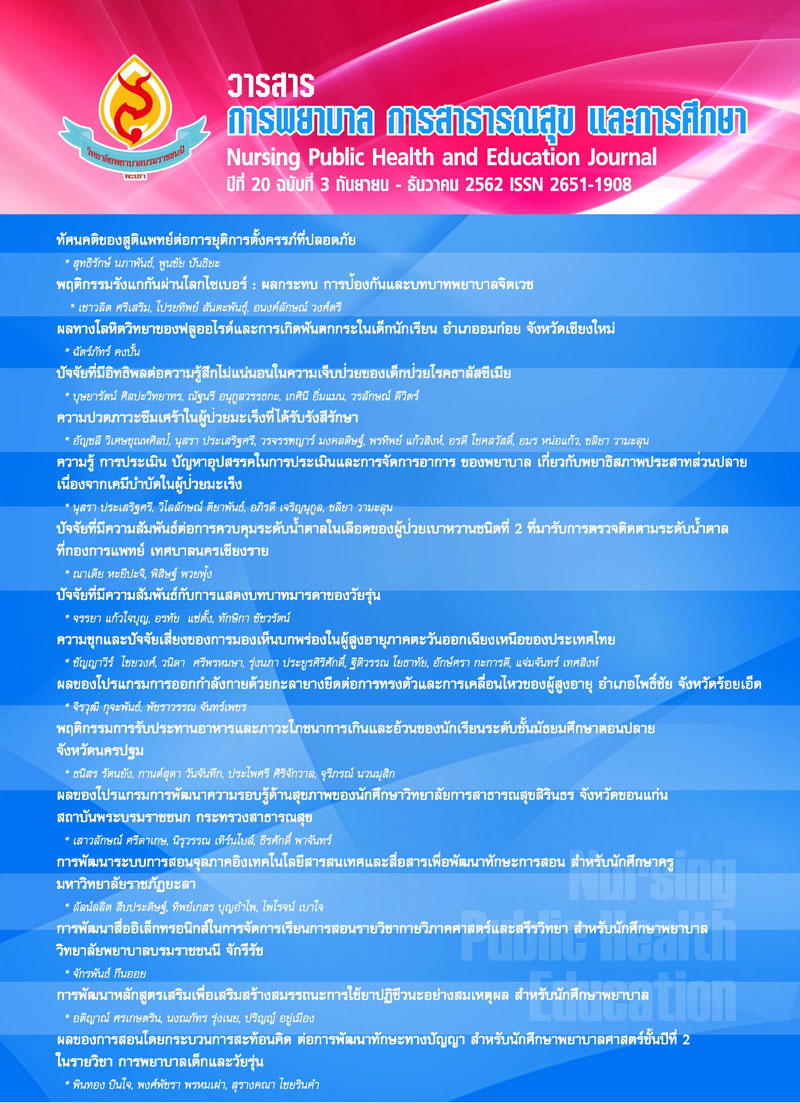ความรู้ การประเมิน ปัญหาอุปสรรคในการประเมิน และการจัดการอาการ ของพยาบาล เกี่ยวกับพยาธิสภาพ ประสาทส่วนปลายเนื่องจากเคมีบำบัดในผู้ป่วยมะเร็ง
คำสำคัญ:
พยาธิสภาพประสาทส่วนปลาย, เคมีบำบัด, ผู้ป่วยมะเร็ง, chemotherapy-induced peripheral neuropathy, Chemotherapy, Cancer Patientsบทคัดย่อ
พยาธิสภาพประสาทส่วนปลายเนื่องจากเคมีบำบัด (Chemotherapy- Induced Peripheral Neuropathy (CIPN)) เป็นสาเหตุทำให้ผู้ป่วยมะเร็งที่รักษาด้วยเคมีบำบัดอาจจะต้องลดขนาดของยา หรือหยุดการรักษาด้วยเคมีบำบัด พยาบาลมีบทบาทที่สำคัญในการดูแลผู้ป่วยที่มีภาวะ CIPN แต่พบว่ายังมีข้อมูลจำกัดในการศึกษาเกี่ยวกับความรู้ การประเมิน ปัญหาและอุปสรรคในการประเมิน และการจัดการอาการ ของพยาบาลไทยวัตถุประสงค์การวิจัยครั้งนี้เพื่อศึกษา ความรู้ การประเมิน ปัญหาและอุปสรรคในการประเมิน และการจัดการอาการ ของพยาบาล เกี่ยวกับ CIPN การวิจัยครั้งนี้เป็นการวิจัยเชิงพรรณนา แบบภาคตัดขวางกลุ่มตัวอย่างเป็นพยาบาลวิชาชีพปฏิบัติงานในโรงพยาบาลมะเร็ง จำนวน 118 คนเก็บรวบรวมข้อมูลด้วยแบบสอบถาม Peripheral Neuropathy Survey Thai Version ประกอบด้วยข้อคำถามเกี่ยวกับความรู้เรื่องยาที่ทำให้เกิด CIPN การประเมิน การจัดการการป้องกัน CIPN และอุปสรรคการประเมิน CIPN จำนวน 30 ข้อ ประเมินความตรงของเครื่องมือ ค่า IOC รายข้อ อยู่ระหว่าง 0.67-1.0 ทดสอบความเที่ยงของเครื่องมือค่า Cronbach Alpha Coefficient ได้ 0.89 วิเคราะห์ข้อมูลด้วยสถิติเชิงพรรณนาได้แก่ ความถี่ ร้อยละ ค่าเฉลี่ย และส่วนเบี่ยงเบนมาตรฐาน ผลการวิจัย พบว่า พยาบาลส่วนใหญ่มีความรู้เกี่ยวยาเคมีบำบัดที่มีผลต่อระบบประสาทส่วนปลาย โดยระบุ Platinum ร้อยละ 87.3 Taxanes ร้อยละ 82.2 และ อัลคาลอย ร้อยละ 67.8 ที่ทำลายประสาทส่วนปลาย และที่ตอบถูกต้องจำนวนน้อยคือ Thalidomide หรือ Lenalidomide ร้อยละ 14.4 และ Ipiliumamab ร้อยละ 11ทำลายประสาทส่วนปลาย พยาบาลประเมินผู้ป่วย CIPN ด้วยเครื่องมือมาตรฐานและการตรวจร่างกาย เป็นบางครั้ง ปัญหาและอุปสรรคการประเมิน CIPN คือ การเข้าถึงเครื่องมือ ทักษะประเมิน และความมั่นใจในการประเมิน การรักษาและป้องกัน CIPN ด้วย Duloxetine ตอบถูกร้อยละ 16.9 โดยสรุปพยาบาลมีความรู้เกี่ยวกับยาบางกลุ่มที่ทำให้เกิด CIPN แต่มีการบูรณาการ การประเมินด้วยเครื่องมือมาตรฐานในการปฏิบัติทางการพยาบาลในบางครั้ง พยาบาลจำนวนน้อยที่เข้าใจการป้องกันจัดการอาการ CIPN ข้อเสนอแนะคือการให้ความรู้ และทักษะเกี่ยวกับการประเมิน CIPN สำหรับพยาบาลผู้ดูแลผู้ป่วยมะเร็งที่ให้การรักษาด้วยเคมีบำบัด
Knowledge, Assessments, Barriers of Assessment and Management of NursesRegarding to Chemotherapy-Induced Peripheral Neuropathy in Cancer Patients
Chemotherapy-induced peripheral neuropathy (CIPN) causing reduce dose and lead to failure chemotherapy treatment. Nurses play a critical role in caring for CIPN patients. However, there has not been studied so far in Thai nurses regarding to knowledge, assessment, barriers related to CIPN assessment and CIPN symptom management. The purpose of this research was to study nurses’ knowledge, practice patterns assessment, barriers related to CIPN assessment and CIPN symptom management. Cross-sectional Descriptive design was conducted. The sample consisted of 118 registered nurses who worked in a cancer hospital. Peripheral Neuropathy Survey Thai Version was administered that consisted of knowledge, assessment, barriers related to CIPN assessment and CIPN symptom management 30 items.Content validity was verified, Item-Objective Congruence Index (IOC) was 0.6-1.0 and Internal Consistency reliability was tested, Cronbach Alpha Coefficient was 0.89.Descriptive statistic was used to analyze data including frequency, percentage, mean and standard deviation.The results showed that most sample had knowledge of chemotherapy regarding neurotoxicity of specific agents identify platinum (87.3%), taxanes (82.2%), alkaloid (67.8%) that damage the peripheral nerves, but only a small percentage of the sample were correct Thalidomide or Lenalidomide (14.4%) and Ipiliumamab (11%) that damage the peripheral nerves. The sample sometime performed using standardized tools and neurologic assessments for CIPN. The most frequently reported barriers to CIPN assessment included lack of access to measurement tools, specialized skills needed for assessment, and confidence of assessment. Treatment and prevention of CIPN with Duloxetine,the samples’ answerwas 16.9 percentcorrect.In summary, nurseshave knowledge about certain drugs that cause CIPN but they sometime integrated using standardized tools for CIPN assessment in their practices. There were small number of nurses who understand prevention and management of CIPN symptoms.The suggestion is continuing educational offerings should incorporate knowledge and skillsfor assessing CIPN for nurses who care cancer patients undergoing chemotherapy.
เอกสารอ้างอิง
Binner, M., Ross, D., & Browner, I. (2011). Chemotherapy-induced peripheral neuropathy: assessment of oncology nurses' knowledge and practice. Paper presented at the Oncology nursing forum.
Bray, F., Ferlay, J., Soerjomataram, I., Siegel, R. L., Torre, L. A., & Jemal, A. (2018). Global cancer statistics 2018: GLOBOCAN estimates of incidence and mortality worldwide for 36 cancers in 185 countries. CA: a cancer journal for clinicians, 68(6), 394-424.
Fukuda, Y., Li, Y., & Segal, R. A. (2017). A mechanistic understanding of axon degeneration in chemotherapy-induced peripheral neuropathy. Frontiers in neuroscience, 11, 481.
Hershman, D. L., Lacchetti, C., Dworkin, R. H., Lavoie Smith, E. M., Bleeker, J., Cavaletti, G., . . . Lustberg, M. B. (2014). Prevention and management of chemotherapy-induced peripheral neuropathy in survivors of adult cancers: American Society of Clinical Oncology clinical practice guideline. Journal of Clinical Oncology, 32(18), 1941-1967.
Seretny, M., Currie, G. L., Sena, E. S., Ramnarine, S., Grant, R., MacLeod, M. R., . . . Fallon, M. (2014). Incidence, prevalence, and predictors of chemotherapy-induced peripheral neuropathy: a systematic review and meta-analysis. PAIN®, 155(12), 2461-2470.
Simon, N. B., Danso, M. A., Alberico, T. A., Basch, E., & Bennett, A. V. (2017). The prevalence and pattern of chemotherapy-induced peripheral neuropathy among women with breast cancer receiving care in a large community oncology practice. Quality of Life Research, 26(10), 2763-2772.
Smith, E., Campbell, G., Tofthagen, C., Kottschade, L., Collins, M., Warton, C., . . . Visovsky, C. (2014). Nursing knowledge, practice patterns, and learning preferences regarding chemotherapy-induced peripheral neuropathy. Paper presented at the Oncology nursing forum.
Smith, E. M. L., Pang, H., Cirrincione, C., Fleishman, S., Paskett, E. D., Ahles, T., . . . Le-Lindqwister, N. (2013). Effect of duloxetine on pain, function, and quality of life among patients with chemotherapy-induced painful peripheral neuropathy: a randomized clinical trial. Jama, 309(13), 1359-1367.
Tofthagen, C., Visovsky, C., & Rodriguez, R. (2013). Chemotherapy-induced peripheral neuropathy: an algorithm to guide nursing management. Clinical journal of oncology nursing, 17(2), 138.
Vasquez, S., Guidon, M., McHugh, E., Lennon, O., Grogan, L., & Breathnach, O. S. (2014). Chemotherapy induced peripheral neuropathy: the modified total neuropathy score in clinical practice. Irish journal of medical science, 183(1), 53-58.
Visovsky, C., Haas, M., Faiman, B., Kurtin, S., Shaftic, A. M., Lyden, E., & Rice, J. (2012). Nurse self-evaluation of assessment of chemotherapy-induced peripheral neuropathy in patients with cancer. Journal of the advanced practitioner in oncology, 3(5), 319.
Winters-Stone, K. M., Horak, F., Jacobs, P. G., Trubowitz, P., Dieckmann, N. F., Stoyles, S., & Faithfull, S. (2017). Falls, functioning, and disability among women with persistent symptoms of chemotherapy-induced peripheral neuropathy. Journal of Clinical Oncology, 35(23), 2604.



